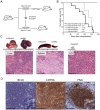Ectopic expression of transcription factor BATF3 induces B-cell lymphomas in a murine B-cell transplantation model
- PMID: 29662618
- PMCID: PMC5882309
- DOI: 10.18632/oncotarget.24639
Ectopic expression of transcription factor BATF3 induces B-cell lymphomas in a murine B-cell transplantation model
Abstract
The mechanisms involved in malignant transformation of mature B and T lymphocytes are still poorly understood. In a previous study, we compared gene expression profiles of the tumor cells of Hodgkin lymphoma (HL) and anaplastic large cell lymphoma (ALCL) to their normal cellular counterparts and found the basic leucine zipper protein ATF-like 3 (BATF3) to be significantly upregulated in the tumor cells of both entities. To assess the oncogenic potential of BATF3 in lymphomagenesis and to dissect the molecular interactions of BATF3 in lymphoma cells, we retrovirally transduced murine mature T and B cells with a BATF3-encoding viral vector and transplanted each population into Rag1-deficient recipients. Intriguingly, BATF3-expressing B lymphocytes readily induced B-cell lymphomas after characteristic latencies, whereas T-cell transplanted animals remained healthy throughout the observation time. Further analyses revealed a germinal center B-cell-like phenotype of most BATF3-initiated lymphomas. In a multiple myeloma cell line, BATF3 inhibited BLIMP1 expression, potentially illuminating an oncogenic action of BATF3 in B-cell lymphomagenesis. In conclusion, BATF3 overexpression induces malignant transformation of mature B cells and might serve as a potential target in B-cell lymphoma treatment.
Keywords: B-cell immunology; B-cell lymphoma; BATF3; germinal center; oncogene.
Conflict of interest statement
CONFLICTS OF INTEREST The authors declare no competing financial interests.
Figures




References
-
- Küppers R. Mechanisms of B-cell lymphoma pathogenesis. Nat Rev Cancer. 2005;5:251–262. - PubMed
-
- Küppers R, Dalla-Favera R. Mechanisms of chromosomal translocations in B cell lymphomas. Oncogene. 2001;20:5580–5594. - PubMed
-
- MacLennan IC. Germinal centers. Annu Rev Immunol. 1994;12:117–139. - PubMed
-
- Seifert M, Scholtysik R, Küppers R. Origin and pathogenesis of B cell lymphomas. Methods Mol Biol. 2013;971:1–25. - PubMed
-
- Shaffer AL, Lin KI, Kuo TC, Yu X, Hurt EM, Rosenwald A, Giltnane JM, Yang L, Zhao H, Calame K, Staudt LM. Blimp-1 orchestrates plasma cell differentiation by extinguishing the mature B cell gene expression program. Immunity. 2002;17:51–62. - PubMed
LinkOut - more resources
Full Text Sources
Other Literature Sources

